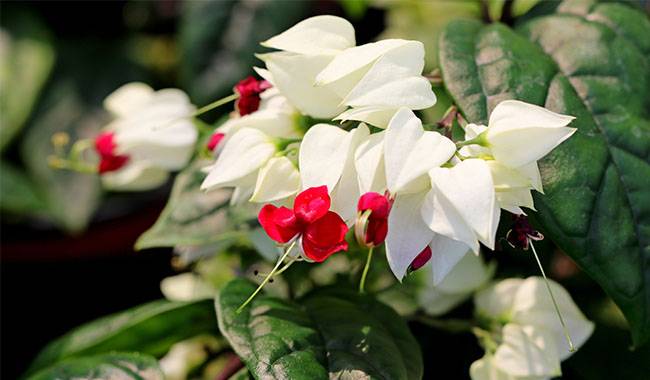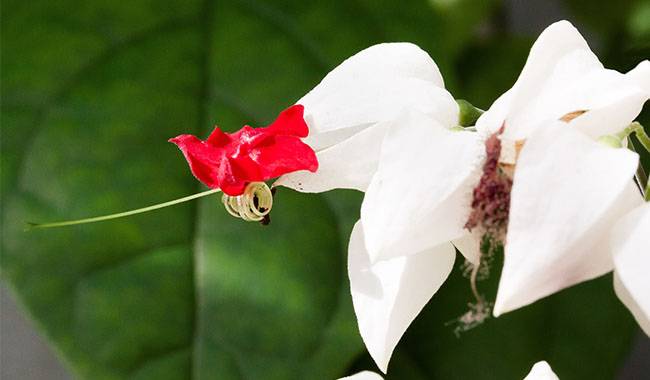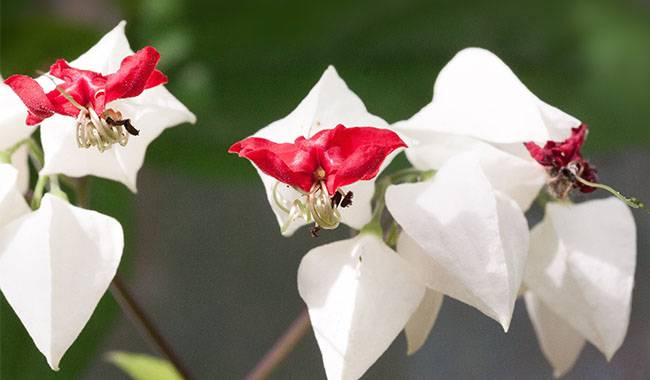
Gorgeous, exquisite, atmospheric, incomparable – these are the adjectives that come to mind when I admire a Clerodendrum in full bloom. I’ve had it for four years now, but I couldn’t get used to it. A neighbor gave it to me when she moved in. She didn’t tell me anything, assuring me that I would figure it out on my own. I started looking up information and found a lot of interesting things. In particular, there is a very beautiful legend associated with this flower and that it doesn’t bloom in every home. I would like to share with you my love for the “Tree of Destiny”. You will learn Clerodendrum Growing Guide in the ThumbGarden article.
CLERODENDRUM PLANT – A FLOWER OF GOOD SPIRIT
Interestingly, it has only recently begun to be cultivated as a house plant and has gained well-deserved popularity among flower growers. Interior designers have also taken note of this touching and delicate plant. It looks great in winter gardens and interiors with romantic overtones.
Contemplating its flowers is said to bring not only aesthetic pleasure but also to put the mind in a positive state and relieve stress and excessive irritability. Endorsement!
This plant has several folk names such as “Rose Glory Bower” or “Starburst Clerodendrum”. At first, I found it strange that the nickname “Tree of Destiny” was the main one, even though my Clerodendrum is structurally clearly a vine. It needs support and space, and then the flexible branches and dark green fan-shaped leaves can stretch up to 10 feet (3 meters).
Clerodendrum thomsoniae (Bleeding-heart vine). As I became interested, I discovered that there are some taller species that have the word “tree” in their names.
- the most beautiful.
- fragrant.
- Ugandan.
All varieties of Clerodendrum have a subtle, pleasant fragrance with a distinctive flavor that is thought to have antidepressant properties.
GROWING CONDITIONS AND CARE OF CLERODENDRUM

The most important thing for the plant is the correct temperature regime, which will get through other deficiencies without too much loss. Too long interruptions in watering and fertilization can lead to the loss of its decorative appearance. Clerodendrum appearance will tell you what it is missing.
In order for it to grow well and bloom a lot, you must create the right conditions for the plant.
- Lighting needs to be diffused and of medium intensity.
- The best place to live is on a west or east window.
- When the soil becomes dry, water heavily and use only room temperature rainwater.
- Fertilize twice a month during the flowering period, starting in April and ending in September.
- Humidity is very demanding for Clerodendrum, and I sprinkle it with water every day, for which it thanks with a long-lasting flowering period.
- It is important to have a temperature change (cool overwintering) that mimics the natural cycle and stimulates the establishment of flower buds.
Pruning
A characteristic of Clerodendrum is the rapid growth of its green masses. If left untreated, shoots will grow to 11.5 feet (3.5 m) and have a very untidy appearance. Pruning is a must for this plant.
I pruned it at the end of February. Three types of canopy formation are allowed: Ampelopsis, Shrubby, and Stumpy. I prefer the climbing type, for which I keep the length almost untouched, but pinch off the shoots on the sides and carefully cut back the shrubs.
Clerodendrum dormant
The dormant period is in autumn and winter. After flowering, I remove the stems and move the pots to a shady porch. Reduce watering, but do not let the root ball dry out completely.
The end of “hibernation” is signaled by the appearance of new tender leaves. It is then time to repot the clover in a larger pot and bring it to a warmer room.
Propagation methods for Clerodendrum
The easiest way is to cut off half of the trunk, apply rhizome to the cut, and plant it in moist soil. I have tried putting a flower in water. In principle, the result is almost the same. The roots were slower to form in the mulched soil, but there were no adaptation problems after replanting.
If you can’t buy seedlings and want to have a tree of destiny at home, you can buy seeds. There is still a lot to do. With constant monitoring of humidity and light quality, it takes 6-9 weeks for seedlings to emerge.
The sowing date is late February or early March. To make germination faster, for most plants, I put a mini-greenhouse on top. I have planted clerodendrum in this way only once at the request of a friend, and then I gave up bothering with it. In addition, when it blooms, it does not look like the original image and does not retain the properties of the parents.
WHY DON’T CLERODENDRUM PLANTS BLOOM?

There are various magical properties attributed to Clerodendrum, attributing the lack of flower buds to negative energy. But, of course, the reasons are more prosaic and stem from improper care of the plant.
- Clerodendrum does not flower unless they spend a dormant period in a cool place. There is no reason for the plant to form flowering stems at a constant temperature.
- Dry air is considered unfavorable by the flowers. To promote flowering, daily moistening is necessary.
- Narrow pots depress the root system, and the root system of Clerodendrum is very fragile and vulnerable. Young plants should be replanted annually, increasing the volume of the container by 1-2 inches (2.5-5 cm). With enough space, the flowers will develop harmoniously and be full of energy for new blooms.
- Lack of sunlight is also seen as a threat that can cause already picked flower buds to fall off.
- Excessive nitrogen in the fertilizer diverts nutrients to green growth, leaving no energy for the flower buds.
- This plant likes humidity and remembers the humid tropics on a genetic level. However, regular overfilling is detrimental to the plant and can lead to root rot and root damage. In this case, Clerodendrum will certainly not flower.
- If there is no or insufficient drainage, waterlogging will occur and the plant will refuse to form flower buds.
Tip: One of the most important conditions for flowering Clerodendrum Thompson can be considered to be timely pruning at the very beginning of the active growth phase. This is the only way to give Clerodendrum the desired shape, remove excess green matter, redirect the life-giving sap to the flower buds and preserve the strength of the plant.
DISEASES AND PESTS OF CLERODENDRUM PLANTS
Insect infestations are rare but common on these houseplants. They are difficult to detect, but changes in leaf structure and color should be a cause for concern. Spider mites and whitefly caterpillars may arrive with new flowers in the store.
If cared for properly, the disease is rare. However, changes in leaf color, shape, and size, thinning leaves, and deformed shoots indicate a lack of light and nutrients. However, if these conditions are met, it is necessary to remove the plant from the pot and inspect the root system.
If rot is present, remove the damaged part with a sharp, sterilized knife, soak the roots in a manganese solution for 40 minutes, and transfer the plant to a new pot and fresh substrate. The old soil must no longer be used.
Dear readers! In practice, I have found that Clerodendrum is not at all capricious, all the conditions for its care are easily met, and inducing it to flower is simple. After a bumper crop of flowers, my Clerodendrum once again went into hibernation. It has kept me happy for almost four months.
It is thought to flower almost all year round, with only a little break in winter. So far, I have not been able to achieve this, which means there is something to look forward to. If you have tips for growing this amazing plant, please share your personal experience, I would be delighted.







